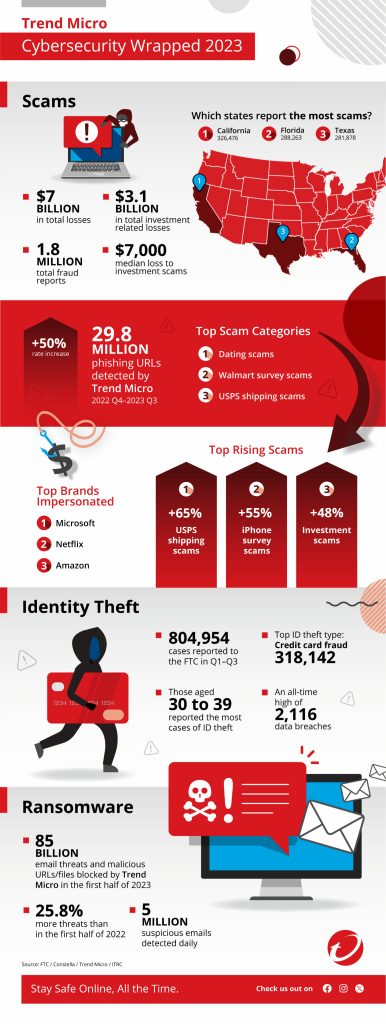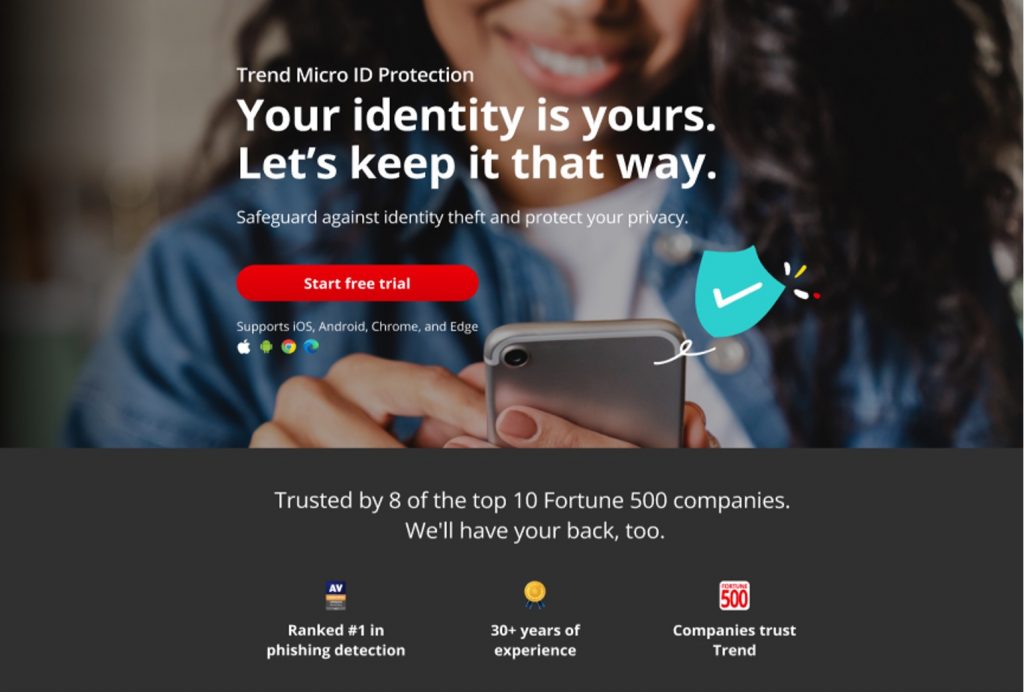2023 was a critical year for cybersecurity. Cybercriminals were working to steal your money and identity — but Trend Micro was working harder to prevent that. In the last twelve months we’ve reported on hundreds of cybersecurity threats and topics, with 140 articles on scams alone. As the holidays approach, we thought we’d provide a rundown of our 2023.

2023 Scams
Scams: the year in numbers
- Toal losses: $7 billion
- Total fraud reports: 1,805,533
- States reporting the most scam cases:
- California
- Florida
- Texas
- Category with most losses:
- Investment-related
- Total losses: $3.1 billion
- Media loss: $7,000
- Top scam categories
- Dating scams
- Walmart survey scams
- USPS shipping scams
- No. of phishing URLs detected by Trend Micro:
- 29,784,057 (2022 Q4 – 2023Q3)
- increase rate: +50%
- Top brands impersonated
- Microsoft
- Netflix
- Amazon
- Top rising scam categories
- USPS shipping scam (+65%)
- iPhone survey scam (+55%)
- Investment scam (+48%)
Just like last year, scams were a constant menace for the American consumer in 2023. We began by reporting on Moziep, an online scam that looked like a retail website but was in the business of stealing money and credentials; and warned you about phishing attacks via Microsoft Forms and Excel. Shortly after that, we looked at Netflix scams for the coming year — not to mention PayPal invoice scams, a common tactic used by cybercriminals.
In February a catastrophic earthquake struck Turkey and Syria, and we turned our attention to the awful individuals who were profiting off of people’s kindness with fake charities. March seemed to be money month, and we looked at tax filing scams as well as Financial Assistance Department scams.
AI brings untold opportunities for everyone — it also brings more scam tactics for cybercriminals, via voice cloning. The last year was tough for cryptocurrency, but it’s still big money, and big business for scammers. Towards the end of spring, people were no doubt looking ahead to summer vacations, and we reported on Delta Air Lines scams.
2023 top 10 consumer scams [TM]:
- Walmart Survey Scam
- USPS Shipping Scam
- Amazon Phishing
- Australia Post Scam
- Costco Survey Scam
- UPS Shipping Scam
- Fake Antivirus
- Apple Survey Scam
- Walmart Gift Card Scam
- iPhone/iPad Survey Scam
In May we ran a great interview with the romance scam activist, Ayleen Charlotte, of Tinder Swindler fame. Summer brought the strange case of the Bella Heather Missing Girl scam. It also brought a new cohort of young jobseekers — just be wary of LinkedIn job scams!
Autumn came along and we turned our attention to Amazon: to fake gift card scams and product tester scams. Then there was the decidedly creepy phenomenon of wrong number scams. Latterly, we covered the plethora of Christmas shopping scams — for example, fake Balsam Hill scams.
2023 Data Security
Data security: the year in numbers
- Total FTC reports: 804,954 (Q1-Q3)
- Top ID theft type: credit card fraud (318,142)
- Ages 30-39 reported the most cases of ID theft.
- 2,116 data breaches, an all-time high. [ITRC]
Identity theft and data breaches are a core worry for the average person and 2023 did little to assuage those fears. We began with a piece on Apple, and their propensity to track customers — even when they shouldn’t be. Regal Medical was the first data breach we covered; not to be outdone, X/Twitter suffered a gigantic data breach that affected 200 million users.
In the spring, both Hatch Bank and Independent Living Systems suffered large data breaches. We figured it was a good time to explain credit freezes, the what, why, and how. In May, OpenAI (creators of ChatGPT) joined the data leak club, and SuperVPN suffered a massive breach not long after, with over 360 million user records affected.
In July, healthcare giant HCA Healthcare suffered a catastrophic breach that affected 11 million patients! In September, we gave you a handy primer on identity theft: what it is and how to protect yourself. Then we turned out attention to the MOVEit vulnerability, which had been behind dozens of damaging data breaches since May. Latterly, we explained credit scores — why they lower, what to do, and when to worry.
Protecting Your Identity and Personal Info
Trend Micro is here to have your back in 2024. We would encourage readers to head over to our new ID Protection platform, which has been designed to meet the security and privacy threats we now all face. With ID Protection, you can:
- Check to see if your data (email, number, password, credit card) has been exposed in a leak, or is up for grabs on the dark web;
- Secure your social media accounts with our Social Media Account Monitoring tool, with which you’ll receive a personalized report;
- Create the strongest tough-to-hack password suggestions from our advanced AI (they’ll be safely stored in your Vault);
- Enjoy a safer browsing experience, as Trend Micro checks websites and prevents trackers.
- Receive comprehensive remediation and insurance services, with 24/7 support.

Offering both free and paid services, ID Protection will ensure you have the best safeguards in place, with 24/7 support available to you through one of the world’s leading cybersecurity companies. Trend Micro is trusted by 8 of the top 10 Fortune 500 Companies — and we’ll have your back, too.
2023 Ransomware and Malware
Ransomware and malware: the year in numbers
- 85 billion email threats and malicious URLs/files blocked by Trend Micro
- 25.8% more than 2022
- 5 million suspicious emails detected daily
- Attacks increased by over 37% in 2023 [Zscaler]
- Average ransomware attack cost: 1.85 million
Ransomware and malware continue to be an ever-present threat. We started with the very popular and very useful “How Do I Know if My Phone Is Infected with Malware? 9 Signs to Beware Of“. Then we explained the browser-hijacker, Poshukash, and how to remove it. Later we reported on malware disguised as Google update error messages.
May saw the Mirai botnet threat, which could infect people’s TP-Link routers. A few days later, we looked at so-called “juice jacking“, a type of cyberattack where a criminal steals data or installs malware on a mobile device using a public USB charging port. “You got owned” is a phrase no one likes to hear — especially when it comes in an email from a ransomware blackmailer.
On that note, we looked at how to tell if an email address is hacked or otherwise compromised. Similarly, as a venue and kitchen for malware, we figured it was time for a deep dive into the dark web. Latterly, we warned about WinRAR vulnerabilities and dangers of file compression — not to mention, how to remove the Atomic Stealer malware from Mac devices.
So there you have it folks, 2023 wrapped, ready for 2024. As always, we hope this article has been an interesting and/or useful read. If so, please do SHARE it with family and friends to help keep the online community secure and informed — and consider leaving a like or comment below. Lastly, do give ID Protection a try — why not give it a go today?
